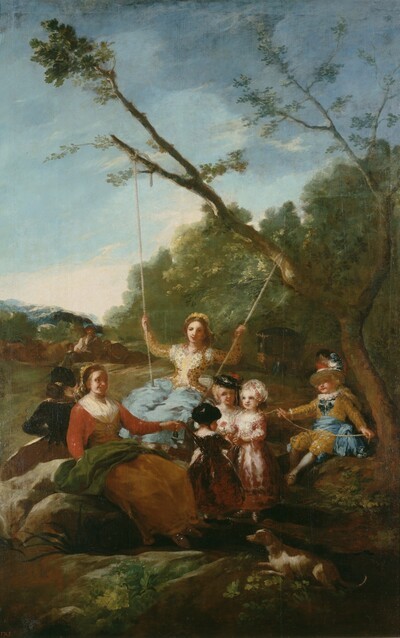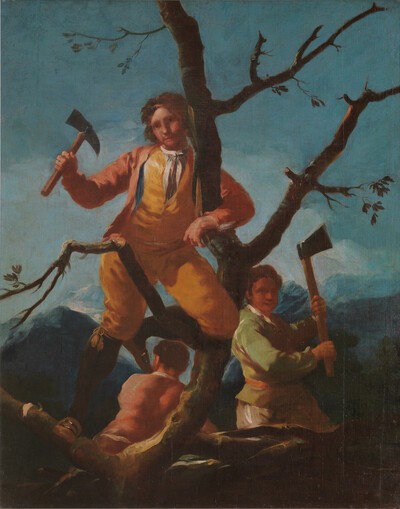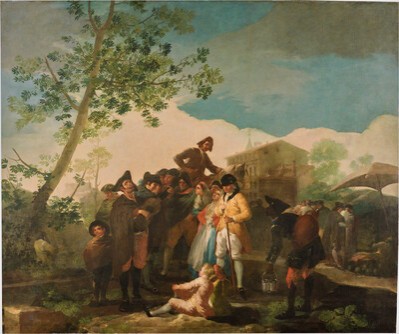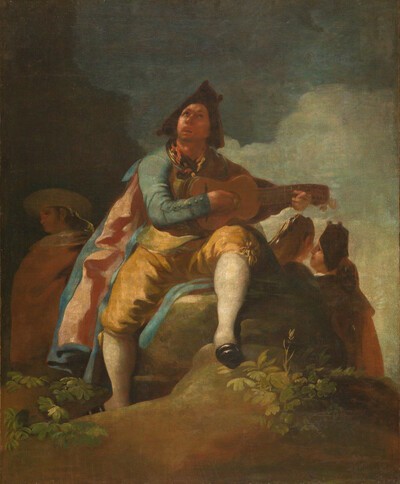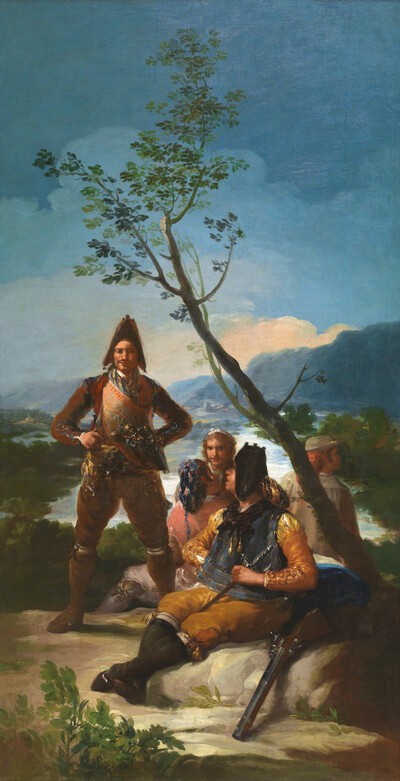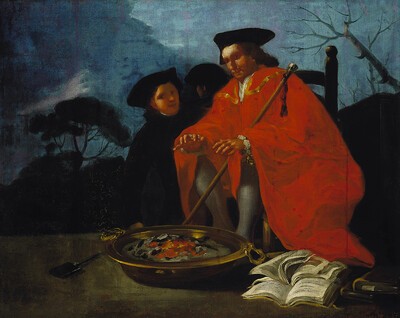- Cronología
- 1779 - 1780
- Ubicación
- The Prado National Museum. Madrid, Madrid, Spain
- Dimensiones
- 100 x 151 cm
- Técnica y soporte
- Oil on canvas
- Reconocimiento de la autoría de Goya
- Documented work
- Titular
- El Prado National Museum
- Ficha: realización/revisión
- 01 Jan 1970 / 14 Jun 2023
- Inventario
- (P00792)
See The Blind Guitarist.
This cartoon was delivered to the Royal Tapestry Factory on 24 January 1780, along with ten other cartoons, completing the decoration of the antechamber to the bedroom. These eleven tapestry cartoons - almost certain to have been made between 21 July 1779, when the artist delivered A Stickball Game and The Swing, and this delivery in January 1780 - were executed very rapidly. It is very likely that Goya was aware of the planned suspension of manufacturing work at the factory and was anxious to finish his commissions and receive his wages.
Around 1856 or 1857, the cartoon was moved from the Royal Tapestry Factory of Santa Bárbara to the Royal Palace in Madrid. In 1870, it was taken to the Prado Museum under orders given on 18 January and 9 February.
This overdoor piece was designed for the east wall of the antechamber to the bedroom, facing the tapestry of The Doctor.
Cruzada Villaamil comments upon the technical laxness of the work, just as Arnaiz, who is of the opinion that the last pieces in this series, i.e. The Woodcutters, The Doctor, Majo with Guitar and this work, are without a doubt inferior to the earlier ones. Camón Aznar, always impressed by Goya's use of colour, describes the woman's dress as one of the best fragments in Goya's work, filled as it is with purple and bluish brilliance.
Nordström identifies this cartoon, just like The Woodcutters, with melancholy. Justification for this reading can be found in the posture of the central female figure resting her head on her hand, in the use of sombre colours, in the bare tree that signals winter, and in the woman's isolation from the rest of the figures that appear behind her. Goya himself described the work by saying that the men are looking upon the sadness of the lady.
Tomlinson takes the iconographic interpretation of melancholy and adds that, in her opinion, the woman's feelings are due to an excess of worldly delights.
-
Tapices y cartones de GoyaPalacio RealMadrid1996organized by Patrimonio Nacional and Sociedad Estatal Goya 96 at the Palacio Real, Madrid, consultant editor Concha Herrero Carretero. May to June 1996cat. 27
-
Goya. 250 AniversarioMuseo Nacional del PradoMadrid1996consultant editor Juan J. Luna. From March 29th to June 2nd 1996cat. 33
-
Goya. La imagen de la mujerMuseo Nacional del PradoMadrid2001from October 30th 2001 to February 10th 2002. Exhibitied also at the National Gallery of Art, Washington, March 10th to June 2nd 2002, consultant editor Francisco Calvo Serrallercat. 6
-
Goya luces y sombrasCaixaForumBarcelona2012consultant editors José Manuel Matilla and Manuela B. Marqués. From March 16th to June 24th 2012cat. 6
-
Goya en Madrid. Cartones para tapices 1775-1794Museo Nacional del PradoMadrid2014p. 233
-
Expérience GoyaLille2021cat. 3
-
Tapices de GoyaMadridPatrimonio Nacional1946pp. 117, 244, cat. 38 y láms. 136-137
-
L'œuvre peint de Goya. 4 volsParís1928-1950vol. I, p. 88, cat. 29
-
Goya, Saturno y melancolía. Consideraciones sobre el arte de GoyaStockholmAlquimis & Wiksell1962pp. 22-31 y p. 23 (il.)
-
Vie et ouvre de Francisco de GoyaParísOffice du livre1970pp. 76, 89, cat. 141
-
BarcelonaPolígrafa1970vol. I, p. 249, cat. 94
-
L’opera pittorica completa di GoyaMilanRizzoli1974p. 95-96, cat. 99
-
Francisco de Goya, 4 vols.ZaragozaCaja de Ahorros de Zaragoza, Aragón y Rioja1980-1982vol. I, p. 114
-
Francisco de Goya, cartones y tapicescol. col. "Espasa Arte"Espasa Calpe1987pp. 110-111, 282, cat. 42C y p. 110 (il.
-
Goya. 250 AniversarioMadridMuseo del Prado1996pp. 312-313, cat. 33 y p. 108 (il.)
-
Salas del Palacio Real de El Pardo para las que se tejieron tapices sobre cartones de Francisco de Goya: identificación de las habitaciones y ajuste de las obras de Goya en los alzados de las paredesin HERRERO CARRETERO, Concha (curator, Tapices y cartones de Goya (catalogue of the exhibition organizated at the Palacio Real de Madrid, from may to june 1996)MadridPatrimonio Nacional, Goya 96, Lunwerg1996p. 168 (il.)
-
Goya en Madrid. Cartones para tapices 1775-1794MadridMuseo Nacional del Prado2014p. 233
-
Expérience Goya (cat. expo)LilleRéunion des Musées Nationaux2021p.20


